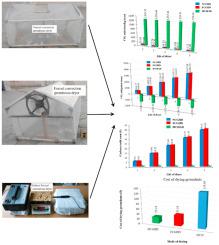Journal of Stored Products Research ( IF 2.7 ) Pub Date : 2021-06-27 , DOI: 10.1016/j.jspr.2021.101848 Mahesh Kumar , Ravinder Kumar Sahdev , Sumit Tiwari , Himanshu Manchanda , Anil Kumar

|
In the present paper, groundnut samples were dried under natural convection greenhouse drying (NCGHD), forced convection greenhouse drying (FCGHD), and indoor forced convection hot air drying (IFCHAD) modes in the climatic conditions of Rohtak, India (28°54′ N 76°34′E). Samples of groundnut were dried up-to-the-safe storage moisture level of 8–10%. Drying cost per kg of dried groundnut under NCGHD, FCGHD, and IFCHAD modes were found to be ₹ (Indian National Rupee) 25.18 (0.34 US$), ₹ 42.18 (0.57 US$), and ₹ 135.85 (1.84 US$), respectively for the same wire mesh sieve size. Cost under greenhouse drying modes decreases with the increase in wire mesh sieve size. Cost under NCGHD and FCGHD modes was 81.46%–69% less than the average drying cost per kg of dried groundnut under IFCHAD mode for the same sieve size. Critical parameters such as embodied energy, energy payback time (EPBT), CO2 mitigation, and carbon credit earn (CCE), which help study the cost analysis of a greenhouse dryer have also been evaluated. Cost of manufacturing a greenhouse decreases with a decrease in embodied energy. Maximum utilization of a greenhouse dryer can reduce CO2 emission. Carbon credit trading is used to control pollution. It provides an economic incentive to achieve a reduction in pollutants emission. EPBT was found to be about 1.66, 1.72, and 4.67 years for natural convection greenhouse dryer, forced convection greenhouse dryer, and hot air dryer, respectively.
中文翻译:

温室和室内强制对流热风干燥机下花生干燥的环境经济可行性
在本文中,花生样品在自然对流温室干燥(NCGHD)、强制对流温室干燥(FCGHD)和室内强制对流热风干燥(IFCHAD)模式下在印度 Rohtak(28°54')的气候条件下进行干燥。北纬 76°34'E)。将花生样品干燥至 8-10% 的安全储存湿度水平。在 NCGHD、FCGHD 和 IFCHAD 模式下,每公斤干花生的干燥成本为 ₹(印度卢比)25.18(0.34美元)、₹42.18(0.57美元)和 ₹135.85(1.84美元)),分别为相同的丝网筛孔尺寸。温室干燥模式下的成本随着丝网筛孔尺寸的增加而降低。NCGHD 和 FCGHD 模式下的成本比 IFCHAD 模式下相同筛子尺寸下每公斤干花生的平均干燥成本低 81.46%–69%。还评估了有助于研究温室干燥机成本分析的关键参数,例如隐含能源、能源回收时间 (EPBT)、CO 2减排和碳信用收益 (CCE)。温室的制造成本随着隐含能源的减少而降低。最大限度地利用温室干燥机可以减少 CO 2排放。碳信用交易用于控制污染。它为减少污染物排放提供了经济激励。发现自然对流温室干燥机、强制对流温室干燥机和热风干燥机的 EPBT 分别约为 1.66、1.72 和 4.67 年。









































 京公网安备 11010802027423号
京公网安备 11010802027423号